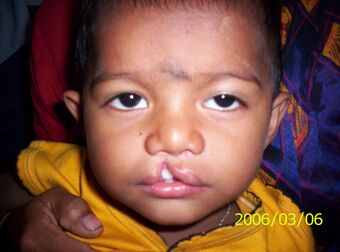Medicine:Juberg-Hayward syndrome
| Juberg-Hayward syndrome | |
|---|---|
| Other names | Cleft lip/palate with abnormal thumbs and microcephaly[1] |
 | |
Juberg-Hayward syndrome is a rare genetic syndrome characterised by cleft lip and cleft palate, microcephaly, ptosis, short stature, hypoplasia or aplasia of thumbs, dislocation of radial head and fusion of humerus and radius. The abnormalities in the arm lead to restriction of movement in the elbow.
Presentation
These include[2]
- Growth retardation
- Microcephaly
- Cleft lip and palate
- Minor vertebral and rib anomalies
- Horseshoe kidneys
- Thumb anomalies
- Triphalangeal thumb
- Radial ray anomalies
Genetics
This syndrome is caused by mutations in the establishment of cohesion 1 homolog 2 (ESCO2) gene.[3] This gene is located on the short arm of chromosome 8 (8p21.1). Mutations in this gene also cause Roberts/SC phocomelia syndrome.[citation needed]
Juberg-Hayward syndrome is inherited in both an autosomal recessive and autosomal dominant fashion.[citation needed]
History
This condition was first described in 1969 by Juberg and Hayward.[4]
References
- ↑ "Juberg-Hayward syndrome | Genetic and Rare Diseases Information Center (GARD) – an NCATS Program". https://rarediseases.info.nih.gov/diseases/3060/juberg-hayward-syndrome. Retrieved 20 July 2020.
- ↑ Verloes A, Le Merrer M , Davin J-C Briard ML, et al (1992) The orocraniodigital syndrome of Juberg and Hayward. J Med Gen 29(4):262-265
- ↑ Kantaputra PN, Dejkhamron P, Intachai W, Ngamphiw C, Kawasaki K, Ohazama A, Krisanaprakornkit S, Olsen B, Tongsima S, Ketudat Cairns JR (2020) Juberg-Hayward syndrome is a cohesinopathy, caused by mutation in ESCO2. Eur J Orthod
- ↑ Juberg RC, Hayward JR (1969) A new familial syndrome of oral, cranial, and digital anomalies. J Pediat 74: 755-762
External links
| Classification |
|---|
 |

